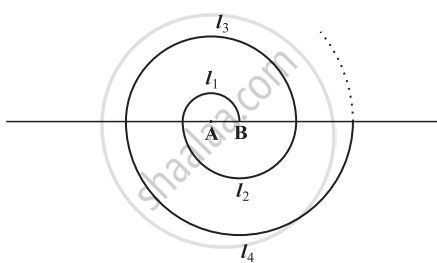Advertisements
Advertisements
प्रश्न
If \[\frac{5 + 9 + 13 + . . . \text{ to n terms} }{7 + 9 + 11 + . . . \text{ to (n + 1) terms}} = \frac{17}{16},\] then n =
पर्याय
8
7
10
11
उत्तर
Here, we are given,
\[\frac{5 + 9 + 13 + . . . \text{ to n terms} }{7 + 9 + 11 + . . . \text{ to (n + 1) terms}} = \frac{17}{16},\] ...........(1)
We need to find n.
So, first let us find out the sum of n terms of the A.P. given in the numerator ( 5 + 9 + 13 + ...) . Here we use the following formula for the sum of n terms of an A.P.,
`S_n = n/2 [ 2a + ( n - 1) d ]`
Where; a = first term for the given A.P.
d = common difference of the given A.P.
n = number of terms
Here,
Common difference of the A.P. (d) = a2 - a1
= 9 - 5
= 4
Number of terms (n) = n
First term for the given A.P. (a) = 5
So, using the formula we get,
`S_n = n/2 [ 2(5) + ( n-1) ( 4) ] `
`= (n/2) [ 10 + (4n - 4)] `
` = ( n/2) (6 +4n) `
= n (3 + 2n) ....(2)
Similarly, we find out the sum of ( n + 1) terms of the A.P. given in the denominator ( 7 + 9 + 11+...) .
Here,
Common difference of the A.P. (d) = a2- a1
= -9 - 7
= 2
Number of terms (n) = n
First term for the given A.P. (a) = 7
So, using the formula we get,
`S_(N+1) = ( n+1)/2 [ 2(7) + [( n + 1 ) - 1](2)]`
`= ((n + 1) /2 )[14 + ( n) ( 2 ) ] `
= ( n + 1 ) ( 7 + n)
= 7n + 7 + n2 + n
= n2 + 8n + 7 ..........(3)
Now substituting the values of (2) and (3) in equation (1), we get,
`(2n^2 + 3n ) /(n^2 + 8n + 7) = 17/16`
16 (2n2 + 3n ) = 17 ( n2+ 8n + 7)
32n2 + 48n = 17n2+ 136n + 119
32n2 - 17n2 + 48n - 136n - 119 = 0
15n2 - 88n - 119 = 0
Further solving the quadratic equation for n by splitting the middle term, we get,
15n2 - 88n - 119 = 0
15n2 - 105n + 17n +- 119 = 0
15n ( n - 7) + 17 ( n - 7) = 0
( 15n + 17 )(n- 7) = 0
So, we get
15n + 17 = 0
15n = - 17
`n = (-17)/15`
Or
n - 7 = 0
n = 7
Since n is a whole number, it cannot be a fraction. So, n = 7
APPEARS IN
संबंधित प्रश्न
A spiral is made up of successive semicircles, with centres alternately at A and B, starting with centre at A of radii 0.5, 1.0 cm, 1.5 cm, 2.0 cm, .... as shown in figure. What is the total length of such a spiral made up of thirteen consecutive semicircles? (Take `pi = 22/7`)

[Hint: Length of successive semicircles is l1, l2, l3, l4, ... with centres at A, B, A, B, ... respectively.]
If the pth term of an A. P. is `1/q` and qth term is `1/p`, prove that the sum of first pq terms of the A. P. is `((pq+1)/2)`.
The 7th term of the an AP is -4 and its 13th term is -16. Find the AP.
If k,(2k - 1) and (2k - 1) are the three successive terms of an AP, find the value of k.
In an A.P. 17th term is 7 more than its 10th term. Find the common difference.
Choose the correct alternative answer for the following question .
The sequence –10, –6, –2, 2,...
The sum of the first n terms of an A.P. is 3n2 + 6n. Find the nth term of this A.P.
In an AP. Sp = q, Sq = p and Sr denotes the sum of first r terms. Then, Sp+q is equal to
The sum of first n terms of an A.P. whose first term is 8 and the common difference is 20 equal to the sum of first 2n terms of another A.P. whose first term is – 30 and the common difference is 8. Find n.
Find t21, if S41 = 4510 in an A.P.
